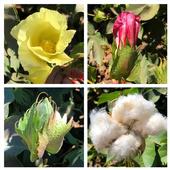- Author: Lynn M. Sosnoskie
Are you considering introducing cover crops into your production system?
Are you wanting to plant hedgerows or wind breaks?
Are you interested in prescribed grazing?
Are you implementing reduced or no-tillage practices?
If your are 1) interested in adopting these or other conservation management strategies (i.e. reduce tillage, riparian plantings, compost additions, etc...) or if your are interested in 2) showcasing your successful implementation of conservation techniques, then there may be funding available to you through CDFA's Healthy Soils Program (HSP).
The HSP has two components:
1)
- Author: Lynn M. Sosnoskie
February is Pesticide Safety Education Month
The second annual National Pesticide Safety Education Month gets underway February 1st, to 1) reinforce core principles of safe handling and use and 2) to raise awareness/support land-grant university Pesticide Safety Education Programs (PSEPs).
The Weed Science Society of America (WSSA), American Phytopathological Society (APS) and Entomological Society of America (ESA) are among the many organizations promoting safe handling and use of pesticides and the important role of PSEPs.
Below is a short video detailing why...
- Author: Lynn M. Sosnoskie
The foundation of an effective extension program is an understanding of needs. Although I have worked in California, previously (2012-2017), as a weed scientist with the University of California – Davis, most of my time was spent in specialty crop systems (trees and vines, processing tomatoes, and melons). Consequently, I entered my current position as an Agronomy and Weed Science Advisor less familiar with the concerns and requirements of the agronomic crop industry. Although I expect that issues such as the water availability and quality, soil health, varietal improvement, and effective pest management practices are of significant interest to my clientele, I engaged in a needs assessment to define and rank the expressed...
- Author: Lynn M. Sosnoskie
Water and water management are crucial to the continuing agricultural prosperity of the San Joaquin Valley. Consequently, the region is lucky to have not one BUT TWO symposia this month discussing water quantity, quality , and management in the Central Valley. Please consider attending if you can.
Merced County Farm Bureau Water Symposium
February 21st, 2019
This event, hosted by the Merced County Farm Bureau at the UC Cooperative Extension Center (2145...
- Author: Lynn M. Sosnoskie

The California Department of Food and Agriculture's (CDFA) recently released statistics review (https://www.cdfa.ca.gov/statistics/) reports that California led the nation in 2017 agricultural cash receipts ($50 billion) followed by Iowa ($27 billion), Texas ($23 billion), Nebraska ($21 billion), and Minnesota ($17 billion). California's (CA) top commodities were dairy ($6.6 billion, up 8.2% from the previous year), grapes ($5.8 billion, up 3.1%), and almonds ($5.6 billion, up 10.9%), followed by berries, cattle and calves, lettuce, walnuts, tomatoes, pistachios, and broilers. With respect to agronomic commodities, hay (all) and cotton (all) were ranked 13th ($758 million) and 18th...



